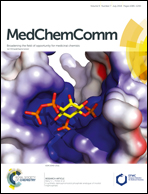Targeting miRNA by tunable small molecule binders: peptidic aminosugar mediated interference in miR-21 biogenesis reverts epithelial to mesenchymal transition†
Abstract
Epithelial to mesenchymal transition (EMT) is a process in which epithelial cells lose cell polarity and cell–cell adhesion and gain migratory and invasive properties to become mesenchymal cells that are very vital for development, wound healing and stem cell behavior and contribute pathologically to fibrosis and cancer progression. miR21, a potent regulator of the tumor suppressor gene PTEN, can be silenced to reverse EMT, thereby providing an attractive target for abrogating the malignant behavior of breast cancer. Here, we report the design, synthesis and binding of a peptidic-aminoglycoside (PA) based chemical library against pre-miR21 that led to the identification of a group of small molecules that bind to pre-miR21 with high affinities and antagonize miR-21 maturation and function, thereby reversing EMT. The approach described here offers a promising miRNA targeting platform where such aminosugar conjugates can be similarly used to target other oncogenic miRNAs. Minor changes in the amino acid sequence allow us to tailor the binding effectiveness and downstream biological effects, thus making this approach a potentially tunable method of regulation of miRNA function.



 Please wait while we load your content...
Please wait while we load your content...